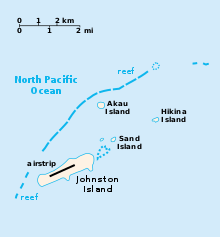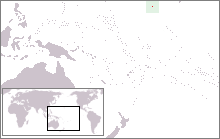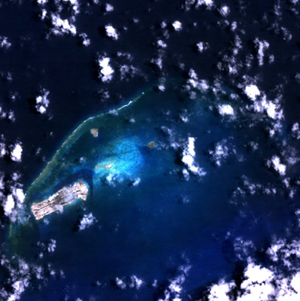

Johnston Atoll is a 1.03 sq mi (2.7 km2) atoll in the North Pacific Ocean[1] about 750 nmi (860 mi; 1,390 km) west of Hawaii. There are four islands located on the coral reef platform, two natural islands, Johnston Island and Sand Island, which have been expanded by coral dredging, as well as North Island (Akau) and East Island (Hikina), an additional two artificial islands formed by coral dredging.[1]
Johnston is an unincorporated territory of the United States, administered by the United States Fish and Wildlife Service of the Department of the Interior as part of the Pacific Remote Islands Marine National Monument. For statistical purposes, Johnston Atoll is grouped as one of the United States Minor Outlying Islands.
Contents[hide] |
[edit] History
| Historical populations | ||
|---|---|---|
| Year | Pop. | %± |
| 1970 | 1,007 | — |
| 1980 | 327 | −67.5% |
| 1990 | 173 | −47.1% |
The American brig Sally—captained by Joseph Pierpont—grounded on a shoal near Johnston Island on September 2, 1796, but did not name or claim the land.[2] The island was named for Captain Charles J. Johnston, commanding officer of HMS Cornwallis, who claimed its official discovery on December 14, 1807. Johnston Atoll was claimed by both the United States and the Kingdom of Hawaii in 1858. The atoll's guano deposits, mined by U.S. interests operating under the Guano Islands Act, were worked until depletion in about 1890.
The island was visited from July 10-22, 1923, and a pioneering aerial photograph was taken then.
On July 29, 1926, by Executive Order, President Calvin Coolidge established Johnston Atoll as a federal bird refuge and placed it under the control of the U.S. Department of Agriculture. On December 29, 1934, President Franklin D. Roosevelt transferred control of Johnston Atoll to the United States Navy in order to establish an air station, and also to the Department of the Interior to administer the bird refuge. In 1936, the Navy began to develop a seaplane base, an airstrip base, and refueling facilities on the atoll. Johnston Atoll was designated as a Naval Defensive Sea Area and Airspace Reservation on 14 February 1941. Johnston Atoll was shelled by lightly armed Japanese submarines once or twice during World War II.
The Johnston Atoll area was used during the 1950s and 1960s as an American nuclear weapons test site—for both above-ground and underground nuclear tests. It was also used for a rocket launch site for some of the first American spy satellites. Later on, it became the site of a chemical weapons depot and the site of the Johnston Atoll Chemical Agent Disposal System (JACADS). All of the chemical weapons that were once stored on Johnston Island have been incinerated, and that process was completed in 2000 and JACADS demolished by 2003.
Between 1958 and 1975, several scientific sounding rockets were launched from Johnston Island.[3] There were also several nuclear test missiles that were launched from Johnston Island in 1962 during the "Operation Dominic" series of nuclear tests, from a launchpad at 16°44′13″N 169°31′26″W / 16.7370°N 169.5240°W. Twelve thermonuclear warheads were exploded in all, one of which failed when the PGM-17 Thor carrying it failed to launch and scattered plutonium debris over the island. Afterwards, the radioactive debris and soils were placed in a 25 acres (100,000 m2) landfill on the island, along with residue from Agent Orange containers returned from Southeast Asia after the Vietnam War, PCBs, PAHs, dioxins, and sarin nerve gas from the Soviet Union and East Germany.
In 1963, the U.S. Senate ratified the Limited Test Ban Treaty, which contained a provision known as "Safeguard C". Safeguard C was the basis for maintaining Johnston Atoll as a "ready to test" above-ground nuclear testing site should atmospheric nuclear testing ever be deemed to be necessary again. In 1993, Congress appropriated no funds for the Johnston Atoll "Safeguard C" mission, bringing it to an end. Congress redefined the island's military mission as the storage and destruction of chemical weapons.
Johnston Atoll has never had any indigenous inhabitants, although during the late part of the 20th century, there were averages of about 300 American military personnel and 1,000 civilian contractor men present at any given time.[1]
The central means of transportation to this island was the airport, which had a paved military runway. The islands were wired with 13 outgoing and 10 incoming commercial telephone lines, a 60-channel submarine cable, 22 DSN circuits by satellite, an Autodin with standard remote terminal, a digital telephone switch, the Military Affiliated Radio System (MARS station), a UHF/VHF air-ground radio, and a link to the Pacific Consolidated Telecommunications Network (PCTN) satellite.[citation needed] Amateur radio operators occasionally transmitted from the island, using the KH3 callsign prefix.
Johnston Atoll's economic activity was limited to providing services to American military personnel and the contractors residing temporarily on the island. All foodstuffs and manufactured goods were imported. The base had six 2.5 megawatt (MW) electrical generators supplied by the base's support contractor, Holmes and Narver, using Enterprise Engine and Machinery Company DSR-36 diesel engines. The runway was also available to commercial airlines for emergency landings (a fairly common event), and for many years it was a regular stop on Continental Micronesia airline's "island hopper" service between Hawaii and the Marshall Islands.
In 2003, all structures and facilities, including those used in JACADS, were removed, and the runway was marked closed. On August 22, 2006, Johnston Island was struck by Hurricane Ioke. The eastern eye-wall passed directly over the atoll, with winds exceeding 100 mph (160 km/h).
On December 9, 2007, the United States Coast Guard swept the runway at Johnston Island of debris and used the runway in the removal and rescue of an ill Taiwanese fisherman to Oahu, Hawaii. The fisherman was transferred from the Taiwanese fishing vessel Sheng Yi Tsai No. 166 to the Coast Guard buoy tender Kukui on December 6, 2007. The fisherman was transported to the island, and then picked up by a Coast Guard C-130 Hercules rescue plane from Kodiak, Alaska.[4]
Johnston Atoll is a part of the Pacific Remote Islands Marine National Monument, which was proclaimed by President George W. Bush on January 6, 2009.
[edit] Geography
The four islands compose a total land mass of 2.67 km².[1] Due to the atoll's tilt, much of the reef on the southeast portion has subsided. But even though it does not have an encircling reef crest, the reef crest on the northwest portion of the atoll does provide for a shallow lagoon, with depths ranging from 3–10 m (9.8–33 ft).
| Island | Original Size 1942 (ha) | Final Size 1964 (ha) |
|---|---|---|
| Johnston Island | 19 | 241 |
| Sand Island | 4 | 9 |
| North (Akau) Island | - | 10 |
| East (Hikina) Island | - | 7 |
| Johnston Atoll | 23 | 267 |
| Lagoon | 13,000 | 13,000 |
Its climate is tropical but generally dry. Northeast trade winds are consistent and there is little seasonal temperature variation.[1] With elevation ranging from sea level to 5 m (16 ft) at Summit Peak, the islands contain some low-growing vegetation on mostly flat terrain and no natural fresh water resources.[1]
[edit] Wildlife
About 300 species of fish have been recorded from the reefs and inshore waters of the atoll. It is also visited by Green Turtles and Hawaiian Monk Seals. Seabird species recorded as breeding on the atoll include Bulwer's Petrel, Wedge-tailed Shearwater, Christmas Shearwater, White-tailed Tropicbird, Red-tailed Tropicbird, Brown Booby, Red-footed Booby, Masked Booby, Great Frigatebird, Gray-backed Tern, Sooty Tern, Brown Noddy, Black Noddy and White Tern. It is visited by migratory shorebirds, including the Pacific Golden Plover, Wandering Tattler, Bristle-thighed Curlew, Ruddy Turnstone and Sanderling.[5]
[edit] License plates
There were no official license plates issued for use on Johnston Atoll. U.S. government vehicles were issued U.S. government license plates and private vehicles retained the plates from which they were registered. According to reputable license plate collectors, a number of "Johnston Atoll license plates" were created as souvenirs, and have even been sold on-line to collectors, but they were not officially issued.[6][7]





No comments:
Post a Comment